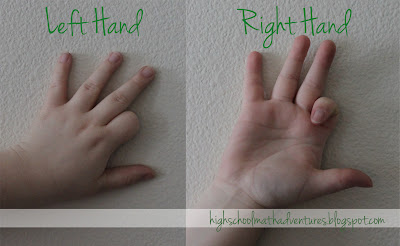I first learned his nifty little trick to help remember the unit circle last year when I was observing in a classroom at a local high school as part of my degree requirement. This wasn't something that the teacher taught, but actually something one of the students shared with her classmates (I am unsure where she learned it). I have also seen it floating around Pinterest, but I wanted to share my version because it can easily be adapted for both left-handed and right-handed people.
Note: This trick was designed only to help remember the first quadrant of the unit circle but I will show you my own little trick to applying it to all of the unit circle.
For this 'trick' to be most effective students should use their glove hand (you know, the hand your glove goes on in baseball/softball; the left for those who are right-handed, and the right for those who are left-handed). The below pictures shows how to hold your hands.
Each one of your five fingers represents a special points on the Unit Circle:
Thumb - 0° or 0π (2π)
Index Finger - 30° or π/6
Middle Finger - 45° or π/4
Ring Finger - 60° or π/3
Pinky Finger - 90° or π/2
Finding Sine and Cosine: First Quadrant
When finding sine and cosine remember your answer always looks like the square root of something over two (√
?/2).
Step one: To find the value for sine/cosine just fold down the respective finger. For example, if we wanted to find sine/cosine values for 30° or π/6 we would fold down the index finger.
Step two: Now we turn our hands into an ordered pair; parentheses on the outside and a comma where the folded down finger is.
So continuing with our example of 30° or π/6 we get (3,1).
Step three: We must now implement what was stated before step one (√
?/2), which gives us (√3/2, √1/). This simplifies to (√3/2, 1/2).
Step four: Since we know on the unit circle, the ordered pairs are presented (cosine, sine) we can conclude that the sin(30°) or sin(π/6) is equal to 1/2 and the cos(30°) or cos(π/6) is equal to √3/2.
Note: This does work for 0° and 90°. 0/2=0 and √4/2=2/2=1.
Finding Sine and Cosine: Second Quadrant
This is almost as easy as the process for Quadrant I, but with a few small changes. First things, first, we need to flip our hands (just like a reflection over the y-axis). Now each finger represents a new point on the unit circle:
Pinky Finger: 90° or π/2
Ring Finger: 120° or 2π/3
Middle Finger: 135° or 3π/4
Index Finger: 150° or 5π/6
Thumb: 180° or π
Now we follow steps one through three for
Finding Sine and Cosine: First Quadrant.
For example, if we were trying to find the sine/cosine values of 120° or 2π/3 we would get (√3/2, 1/2).
Step four: Since we flipped our hands over the y-axis, we now must switch our values in our ordered pair.
Thus we now have (1/2, √3/2).
Step Five: Finally we must apply negative signs where appropriate for the second quadrant (the x-value of the order pair).
Therefore we end up with (-1/2, √3/2) and can conclude that sin(120°) or sin(2π/3) is equal to -1/2 and cos(120°) or cos(2π/3) is equal to √3/2.
Finding Sine and Cosine: Third Quadrant
This is exactly the same as
Finding Sine and Cosine: Second Quadrant, except for step five, we now negate both value of the ordered pair. (You also have to reflective your hand again, this time over the x-axis. Or starting from the original position, rotate 180° counter clockwise. This is an awkward position for the right handed people. Fingers will also now represent new positions on the unit circle.)
Finding Sine and Cosine: Fourth Quadrant
Starting from the original position, flip your hand down (reflect over the x-axis). Fingers will also now represent new positions on the unit circle. (This is an awkward position for the left handed people)
Follow steps one through three for
Finding Sine and Cosine: First Quadrant.
Step four: Apply negative signs where appropriate for the fourth quadrant (the y-value of the order pair).
Finding Tangent:
Follow step one and two for
Finding Sine and Cosine: First Quadrant. Going back to our example of 30° or π/6 we get (3,1).
Step three: Rotate your ordered pair 90° counter clockwise and turn into a fraction.
Step four: Place fraction under radical sign and simplify.
Step five: Now we can conclude that tan(30°) or tan(π/6) is equal to √3/3.
Congratulations if you made it to the bottom of this post. I hope that this all made sense to you. If not, please ask questions, I'm more than happy to help you understand.
If you use this in your classroom, please leave a comment below; I am curious as to how your students will react.















